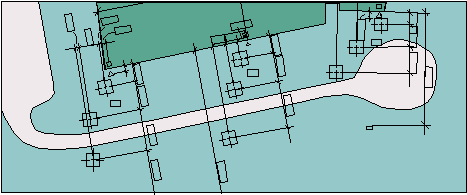Outdoor Lighting Applications Effects of Lamp Type and Light Level
Recent research at the LRC laboratory has demonstrated that metal halide (MH) illumination
results in shorter reaction times to off-axis targets than high pressure sodium (HPS) at low, mesopic levels. For on-axis reaction times and at higher, photopic light levels, MH and HPS at the same light level result in equivalent reaction times. Furthermore, at all levels, MH results in better color accuracy than HPS.
In order to test these results in real applications, the LRC evaluated two lighting installations: a parking lot for a community college, and perimeter lighting for a public high school.
Parking Lot Lighting
The parking lot at Schenectady County Community College in Schenectady, NY was fitted with luminaires using four lamp types: 400-W HPS, 250-W HPS, 250-W MH and 250-W experimental MH lamps designed to maximize mesopic luminous efficacy. Subjects' visual acuity, color naming accuracy, visual search time and off-axis reaction time were measured at night. Subjective ratings including safety, appearance, glare and brightness were also collected. All measurements occurred with and without subjects wearing neutral sunglasses which reduced the effective light level by a factor of ten. Without sunglasses, background luminances with the 400-W HPS lamp ranged from about 1 to 3 cd/m2 color accuracy, subjects' performance and ratings were best for the installations resulting in the highest illuminances, regardless of lamp type. For color accuracy, subjects performed best under MH illumination.

In general, the light levels obtained by the parking lot installation were in the high mesopic range. At these levels, benefits from sources tuned for mesopic vision should not be large.
Schenectady County Community College parking lot
School Perimeter Lighting
The second evaluation, performed at Tamarac High School in Brunswick, NY compared three lamp types: 100-W HPS, 100-W MH and 100-W experimental MH lamps designed to maximize mesopic luminous efficacy. Wall-mounted luminaires containing these lamps were attached to an exterior wall of the school. Students from nearby Tamarac Middle School served as subjects. Subjects' visual acuity, color naming accuracy, and visual search times were measured under several levels ranging from 0.01 to 1 cd/m2.
 Tamarac High School
Tamarac High School
Visual acuity was dependent only on the background luminance. Color accuracy was best under the two MH lamps as expected due to their superior color rendering index (over 70 for MH compared to less than 25 for HPS). Visual search times were largely dependent upon background luminance, but the lamp type also seemed to play an important role, with the experimental MH lamp increasingly better than HPS at lower and lower luminances. This may be because the visual search task has an important off-axis visual component. For such tasks, illumination tuned to mesopic vision could be of benefit at low mesopic levels.
Sponsors:
New York State Energy Research and Development AuthorityNew York Power Authority


